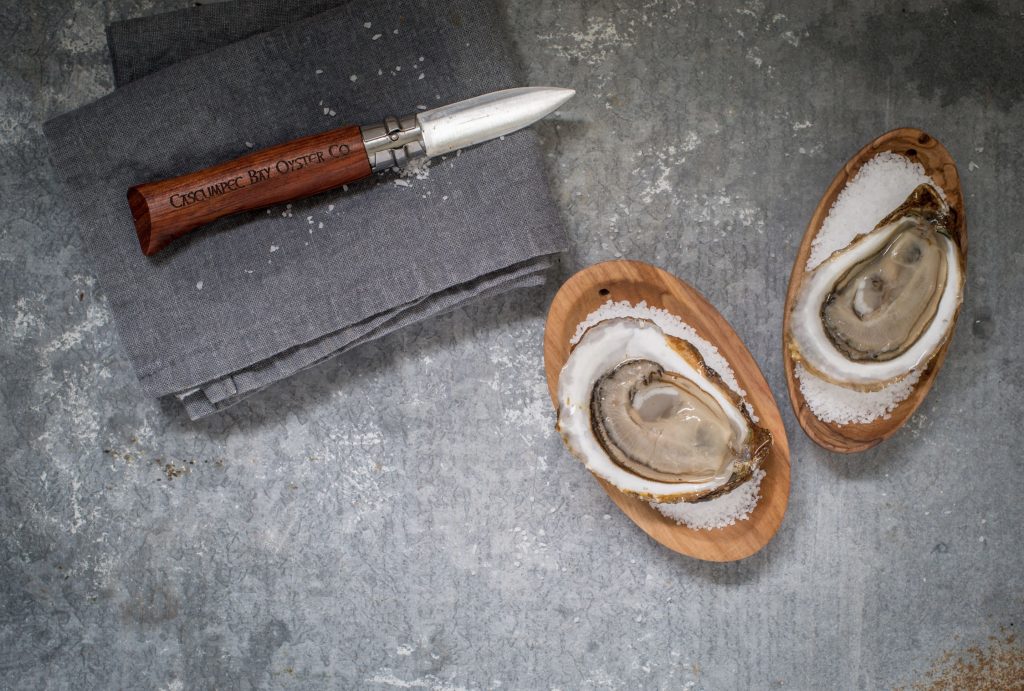
A perfect freshly-shicked Cascumpec oyster. Photo credit: Heather Ogg
Pronounced “Cas-cum-pec”, the name comes from the original native Mi’kmaq name “kaskamkek” meaning “bold sandy shore”. Over time the term changed to the French “Cachcampec”, and then to the English term “Kascumpeck”, with the current spelling being used since 1966.
Seen by many as the quintessential Canadian cultured oyster, the Cascumpec hails from Cascumpec Bay, the last big bay on the western side of Prince Edward Island.
When it comes to describing the provenance of wines one will often hear the term terroir, a word that encapsulates all of the environmental factors contributing to a particular wine’s uniqueness. When referring to the provenance of oysters the term merroir is sometimes used.
With this in mind, the oysters of Cascumpec Bay are sometimes jokingly referred to as the Romanée Conti of the oyster world, with Domaine Romanée Conti or DRC, a wine estate in Burgundy, France, being seen as the source of some of the finest wines in the world.
Martin O’Brien of the Cascumpec Bay Oyster Company tells us that he chose to market his oysters after the Cascumpec Bay location rather than under a gimmicky brand name, especially because of the bay’s pristine waters that are so perfect for oyster cultivation. He explains that when he began marketing them he had no idea how difficult it would be for those unfamiliar with the Cascumpec name to pronounce, “It took a lot of help from the crew at Oyster Boy to teach their wholesale customers and consumers exactly how to say Cascumpec!”
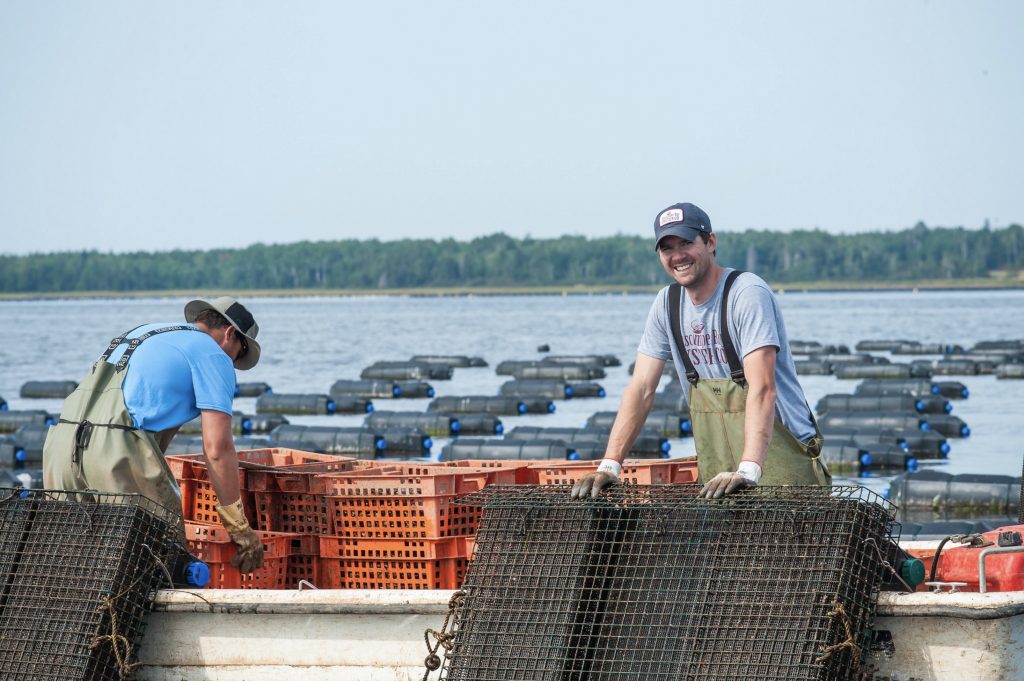
It’s very much a family affair at The Cascumpec Bay Oyster Company. Photo credit : Heather Ogg
Cascumpec Bay Oyster Company is a decidedly family endeavour, with Martin working alongside his business partner Matt Morgan since 2015; growing their own oysters and buying from a number of select growers, Martin and Matt are at the very forefront of oysterculture production in Prince Edward Island.
The Cascumpec Bay’s hard bottom, distribution of eel grass, and nutrient-rich waters have ensured that it has always been regarded as a bountiful bay for shellfish: lobster, mussels, crabs, as well as fish such as eels and silversides. Although the bay is just off the Gulf of Saint Lawrence, it is sheltered by a long stretch of sand dunes typical of the north shore of PEI, making it ideal for traditional inshore fishing in smaller boats. Long recognised as an oyster location of unsurpassed quality, Cascumpec Bay is mentioned multiple times in old texts dating back to the 19th Century.
For generations Cascumpec Bay was one of the most productive oyster areas on PEI, but by the 1970s the natural wild oyster beds had been fished out. Over the last ten years there has been a veritable explosion in oysterculture in the bay. Cascumpec Bay Oyster Co.’s oysters are grown in floating cage oysterculture and then bottom finished.
Martin says that it took around a year to establish his Cascumpec Bay Oysters as solid oysters in the market. Many oyster brands start out strong, but the quality can quickly fade as their orders start ramping up. Martin has always done his very best to maintain that level of quality, even if it means not shipping oysters for a while, “I feel they are considered to be a consistent top shelf oyster and our customers enjoy not having any surprises when they open a box… meaning, they know what they’re getting when they order up our oysters.”
The Cascumpec Bay Oyster Company doesn’t take any shortcuts when it comes to growing their oysters. Growing to full maturity over three to four years, the oysters are seasonally taken from their floating trays and placed in a large rotating cylindrical drum or “tumbler”.
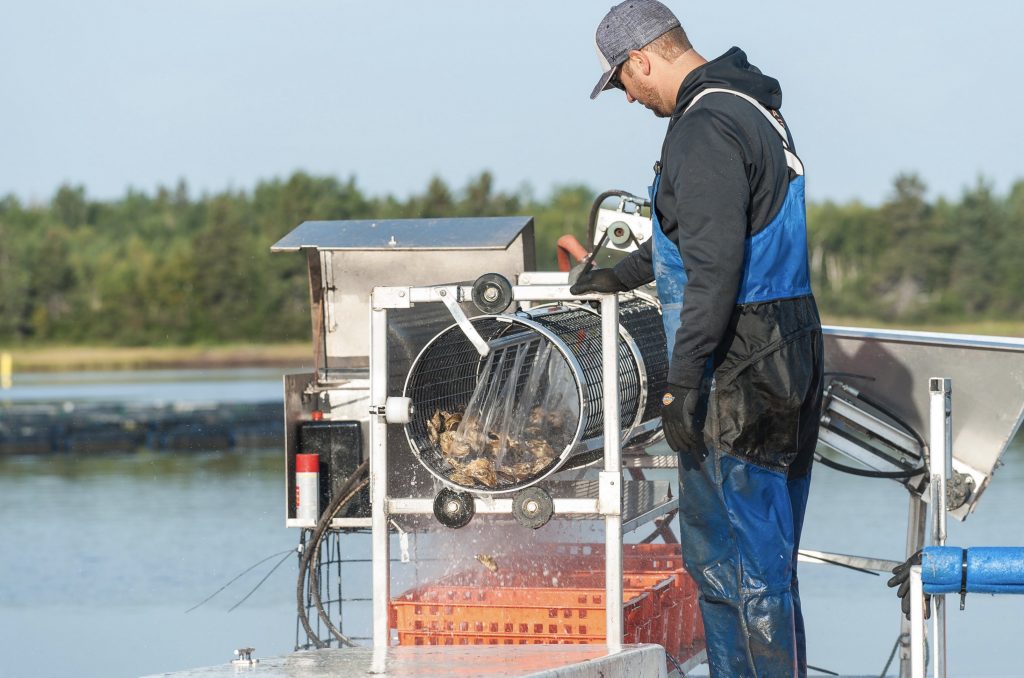
Tumbling the oysters at the Cascumpec Bay Oyster Company. Photo credit : Heather Ogg
Tumbling is a technique used by oyster farmers to grow hardier more uniformly-shaped oysters. In many ways similar to the way in which a judicious gardener prunes a tree, an oyster farmer can tumble an oyster to chip its shell and provoke its natural defence mechanism of growing a thicker shell, encouraging it to “cup up”. The oyster’s shell is thus strengthened making it less brittle and easier to shuck. As it is chipped it into a more rounded shape the meat becomes plumper inside.
All of the Cascumpec Bay Oyster Co.’s oysters come from the Cascumpec Bay watershed, which includes both Foxley and Mill Rivers. Foxley River is a large river that has a lot of aquaculture present, and this is where their farm is based. “There are many influences that make up the taste and appearance of our oysters. One big influence are the peat moss bogs in the Conway Narrows that give our oysters a unique earthy taste and also influences the dark colouring on the shell.”
As well as growing their own oysters, Cascumpec Bay Oyster Company also purchase oysters from two local growers, Aaron Sweet and Pat and Marlene O’Brien.
Aaron Sweet
In 1854, British sailor John Sweet found his way into Cascumpec Bay, PEI. Captivated by its beauty, John vowed to return some day. After 13 more trips around the world, John returned to Cascumpec Bay where his search for perfect soil to grow potatoes took him inland. Six generations later, the search for perfect oyster-growing water brought Aaron and the Sweet family back to Cascumpec Bay, where their company, Sweet Select Oysters, is located today.
Pat and Marlene O’Brien
Pat and Marlene O’Brien, married for over 35 years, were first introduced to oysterculture by a friend in 2007. Pat was no stranger to the water as he had a long career in the traditional fisheries on the island. In 2007, he took the risk of starting an oyster farm and from that day on he adopted the model of growing premium quality oysters. His new challenge became an obsession. You’ll find Pat’s wife Marlene at his side, carefully grading oysters and assuring quality, giving their oysters the nickname “Mom’s Choice”. The O’Brien Farm is nestled in the bay portion of the Foxley River, PEI, right beside the home base of the Cascumpec Bay Oyster Company.
Today you’ll find that the origin of Cascumpec Bay Company Oysters is clearly stated on each box, whether they come from their own farm or from those of growers Sweet and O’Brien. Inside each case you’ll find a “Meet The Grower” card that gives you information about the particular oyster grower in question.
“The reason I chose to create the Meet the Grower cards was because I wanted to give the shucker, be it at a restaurant or at a private party, some talking points and a visual of who actually grew those oysters which they can then pass on to the consumer. When you’re eating oysters, you get a close connection of WHERE they come from because of the unique tastes, so hopefully the cards give a sense of WHO to the consumer after learning and seeing a little bit about the grower.” – Martin O’Brien
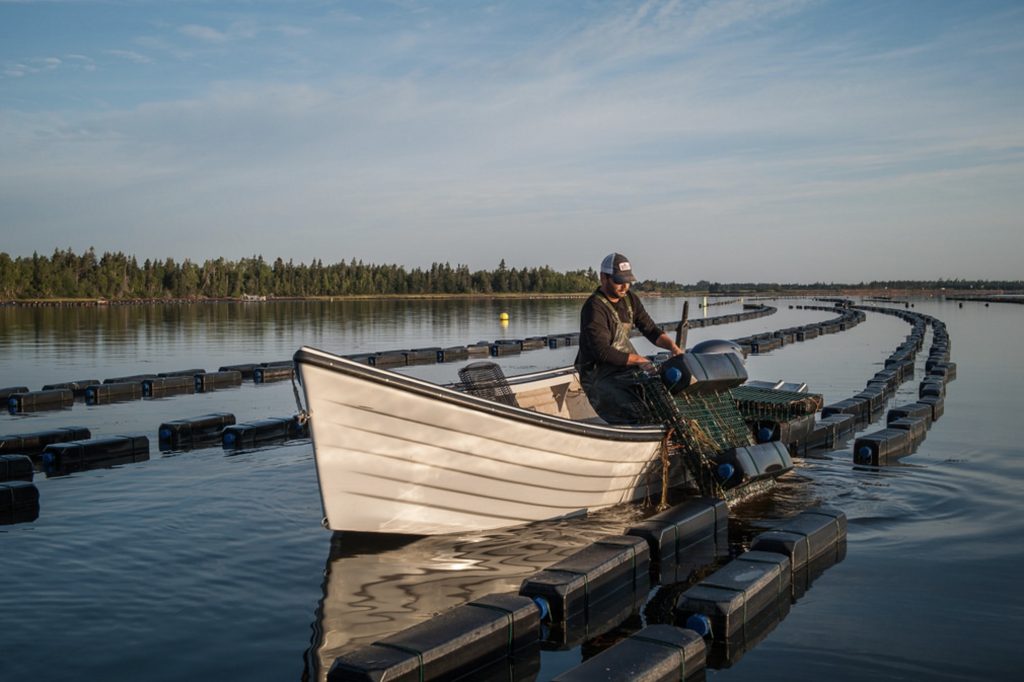
Floating cage oysterculture in Cascumpec Bay, Prince Edward Island. Photo credit : Heather Ogg
The Cascumpec oyster is consistently round or teardrop shape with cocoa brown colouring, sometimes almost black. At their prime they are as meaty as an oyster can get. The Cascumpec medium choice is 3″-3.5″ while the large choice is 3.5″+. The Foxley Rivers are 2″-2.5″, and these are the premium cocktail oysters.
Like all oysters, the Cascumpec changes throughout the year, with less brine in the Spring until the fresh water from the ice and snow clears out, then the saltiness will increase when the weather warms up in May and June. Getting into the Fall, the oysters adds sweetness while they are layering up for the winter. Typically they have a rich, earthy minerality; they have the deepest sense of that “river” taste, that rare deep earthy merroir, but at the same time having a clean and crisp finish, with no lingering aftertaste.
Martin’s ideal pairing with his oysters is beer, but we also enjoy a crisp, dry Ontario Riesling.
Shuck U

Oyster Boy offers an entertaining and informative two hour program that teaches everything you have to know about buying, shucking, and presenting oysters.
An expert oyster shucker will lecture for the first hour on subjects such as; how oysters are grown, how they breed, the life cycle of an oyster, and seasonal variations. In the second hour of Shuck U the professor and assistant will demonstrate how to properly shuck and present an oyster. Students are given 18 oysters and their very own oyster shucking knife and then start practising!
Anyone may sign up for Shuck U; individuals, couples, threesomes! We conduct classes of up to 12 students at a cost of $55 per person on weekend afternoons from 12 noon to 2 pm.
Shuck U is in session all year long. We do take a break from mid March to mid May (spring is truly the cruelest time for oysters), and another from mid July to mid September (breeding time for Canadian oysters). Please email Professor Adam for available dates.
Shuck U always starts at noon, so don’t be late!

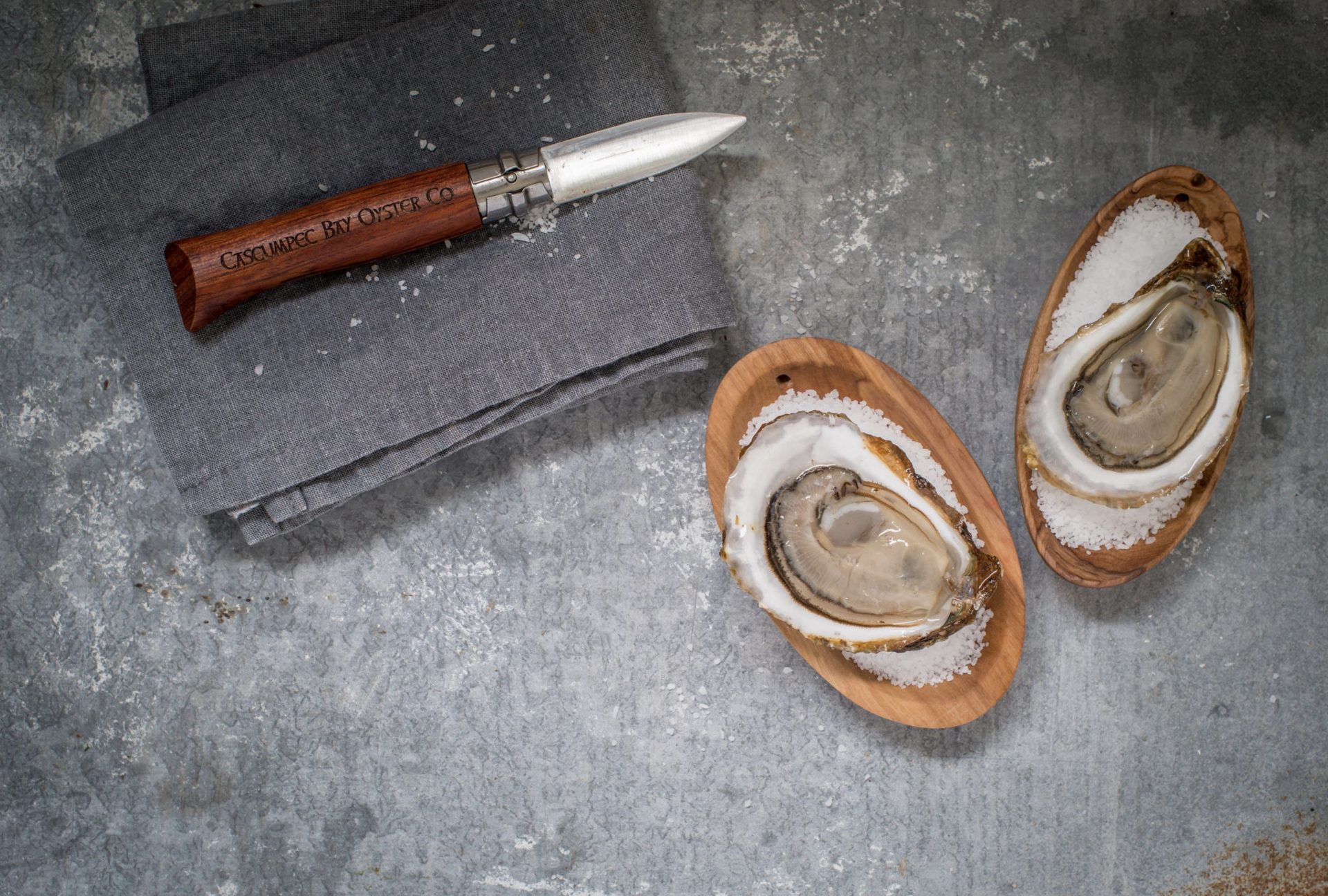






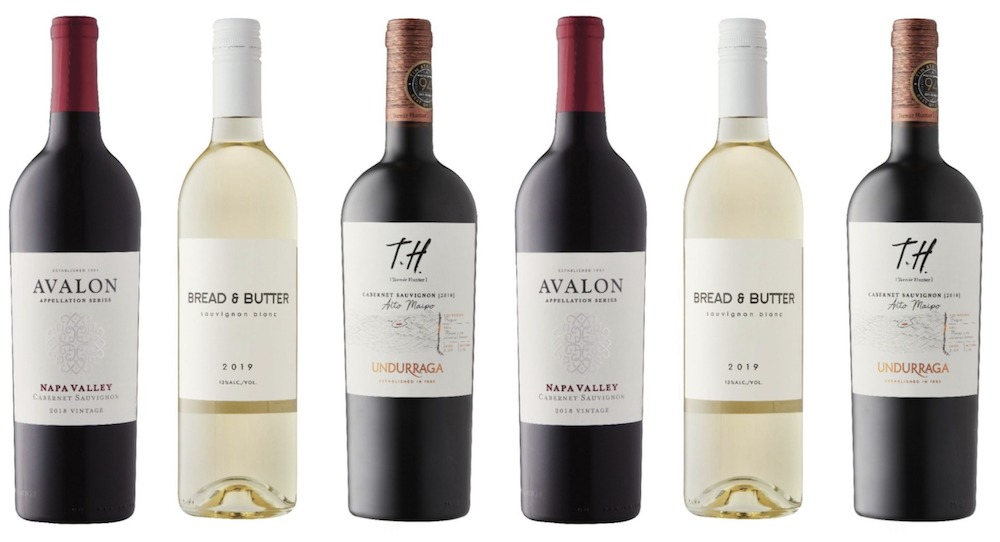
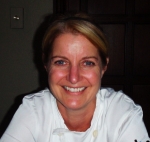
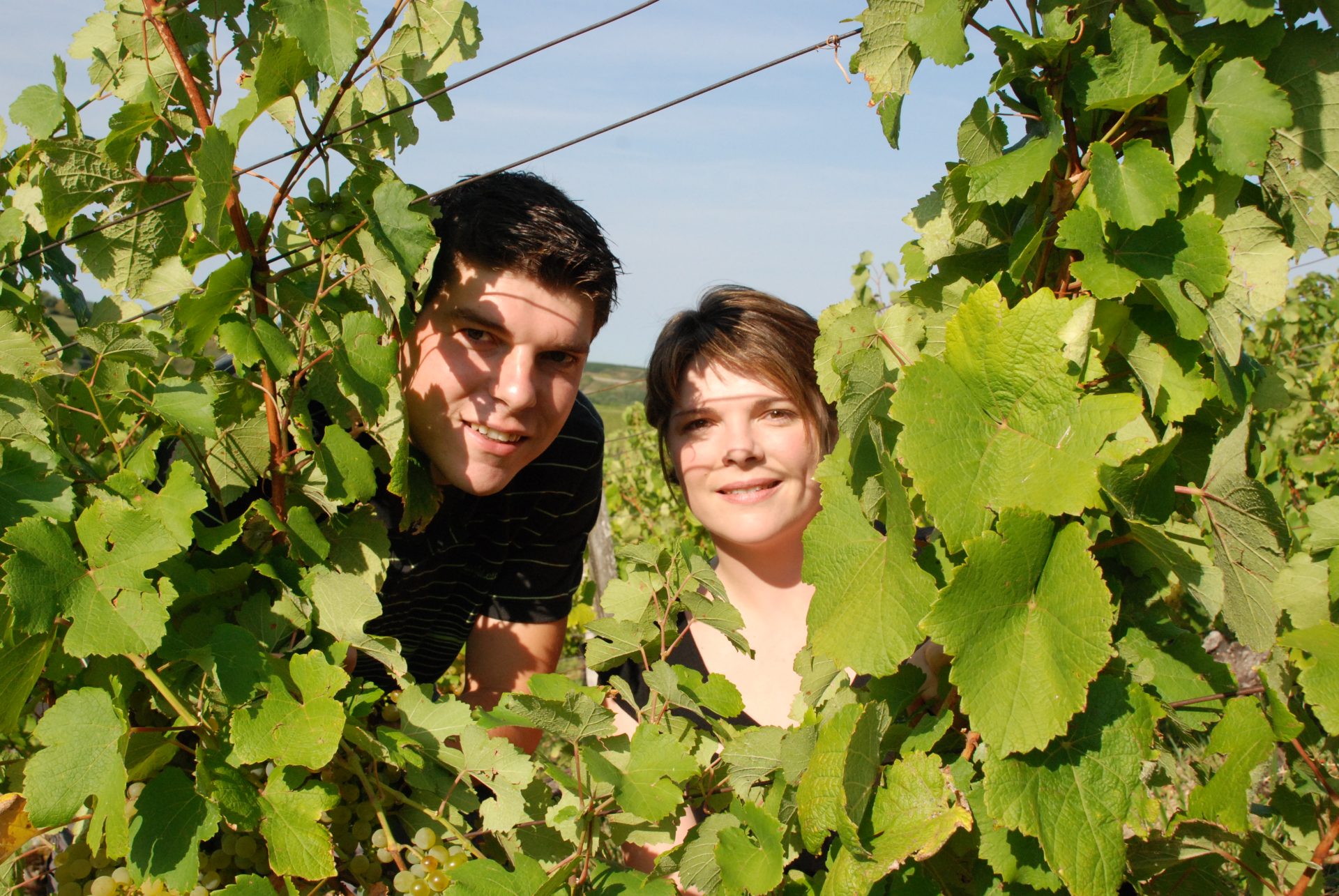
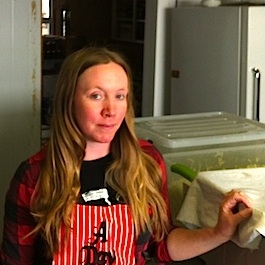

Thanks for the pronunciation, but it’s absolutely worthless until the accent is placed correctly.
Thanks Jim.
What would you suggest?